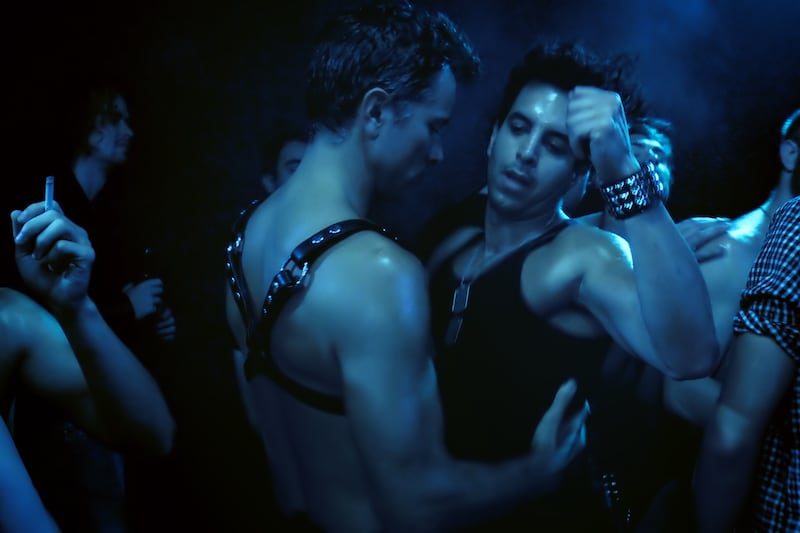The myriad artistic endeavors of Oscar-nominated actor James Franco have, of course, been deconstructed to the point of atomization. Is he a grinning provocateur? A gonzo social satirist? A bored Hollywood actor? Or all of the above? Whatever you think of Franco’s intent, there are two things you’d be hard-pressed to deny: he’s prolific (the guy directed three films, wrote a novel, and acted in six more in 2013), and, well, he’s reckless.

So, in 2012, prior to filming the Disney blockbuster Oz: The Great and Powerful, Franco and pal Travis Mathews co-directed Interior. Leather Bar., a meta-documentary that set out to imagine what the “lost footage” that the MPAA ratings board made director William Friedkin cut from his highly controversial 1980 film Cruising looked like.
Cruising centers on Officer Steve Burns (Al Pacino) who's investigating a series of murders during an awful heat wave in late ‘70s New York City. Police suspect that the perpetrator is a serial killer who picks up gay men at S&M clubs in the Meatpacking District, takes them back to seedy motels, and stabs them to death. So, Pacino’s cop must go undercover at the gay leather clubs of Downtown Manhattan in order to catch the killer. The MPAA made Friedkin cut 40 minutes of footage—much of which, legend has it, featured hardcore gay sex—in order to avoid a dreaded X rating.
ADVERTISEMENT
It’s a problematic film, to say the least—one that depicted Pacino’s descent into the gay underworld as a dark and perilous journey akin to Dante’s descent to hell in his Inferno. There’s a similar scene in Steve McQueen’s Shame in which the sex-addicted protagonist, played by Michael Fassbender, has exhausted all “straight” sexual possibilities, and takes a walk on the wild side. “And that scene where he’s at his lowest point and wants to fuck and goes into a gay club, and it’s depicted like the seventh level of hell,” wrote Franco, “I mean, it goes back to the horrible representations of gays in the '70s, where the gay club is meant to signify everything dark and depraved.”

During the summer of 1979, Village Voice writer Arthur Bell demanded his readers protest the shooting of the film, which “promises to be the most oppressive, ugly, bigoted look at homosexuality ever presented on the screen,” he wrote, “the worst possible nightmare of the most uptight straight. I implore readers… to give Friedkin and his production crew a terrible time if you spot them in your neighborhoods.”
So, Voice readers did everything from blast boomboxes at nearby apartments, fire off air horns, and point mirrors at the shoot to screw up lighting. The acts of sabotage culminated in a thousand protesters marching through the West Village and demanding that Mayor Ed Koch (himself a famous closet case) shut down production.
Friedkin was apologetic about the film, telling HuffPost Live last year, “Gay liberation had begun to make powerful steps forward and I’m sure when Cruising came out, it was not the best foot forward for gay liberation.”
Which brings us to Interior. Leather Bar.
The documentary opens with co-directors Franco and Mathews debating gay marriage while holding meetings with members of the cast.
“The thing that maybe people aren’t looking at is normalizing a queer lifestyle that is incredible valuable and, if [gay marriage] becomes legal nationally, then pressure will be put on anybody that’s living a gay lifestyle to get married,” says Franco.
It then pivots to Franco’s pal of 15 years, Val Lauren, who’s playing the “Pacino role” in their film. Lauren, who also starred as Sal Mineo in Franco’s biopic of the late, openly-gay actor, Sal, released earlier this year, is reluctant about the mystery project—one that, while it consists of a short script treatment, will also give the actors plenty of room for improvisation.
“I don’t personally like this project,” he tells them. “What I do respond to is James’s mission, even when I don’t understand it.”
Later, Lauren is seen receiving a call from his friend while driving to the set of the film.
“I know you’re at the ‘Franco Faggot Project’ today,” the friend says. “I gotta tell you, man, I don’t know where your head is on this, and I think we need to talk about it right away.”
The first thirty minutes of the film consists of the build-up to shooting—mainly, Lauren’s inner struggle of whether or not this is a worthwhile project (and one that will, due to the subject matter and "pornographic" scenes, hurt whatever career he has), as well as the background actor’s—a mix of gay and straight men—expectations of what will follow. Most of the straight actors are worried about potentially having to kiss or fondle other men, while the gay actors mostly, as one actor says, “want to see [Franco] naked.”
Lauren’s apprehension at participating in the film—and its gay scenes—is meant to parallel Pacino’s character’s sense of unease while infiltrating the gay leather clubs. It’s an interesting meditation on straight people’s fears of, as Franco calls it, the “gay lifestyle.” What we witness with Lauren and the other straight actors is a fear of the unknown. Since there’s only a skeleton of a script, they have no clue what they’re about to get themselves into, only that it will be gay-themed. And that’s a large part of where homophobia comes from, isn’t it? Fear of the unknown.
Then, after the thirty minutes of foreplay, we’re treated to five minutes of the recreated Cruising sequence. And yes, it’s pretty racy stuff. Several men—including one in a leather S&M mask—are seen performing oral sex (in close-up) on one another; a man is shown receiving oral sex while puffing away at a cigarette; and there are several close-ups of well-endowed men masturbating. The action then cuts to the Interior. Leather Bar. team filming a scene of a man being brutally paddled, with Franco and Lauren looking on and appearing shocked—yet intrigued. After the scene, Franco consults a visibly shaken Lauren outside and reveals his motivation behind the project:
Franco: “I don’t like the fact that I’ve been brought up to think a certain way. I don’t like realizing my mind has been twisted by the way that the world has been set up around me. And what that is, is straight, normative kind of behavior. And it’s fucking instilled into my brain. And yeah, I’ll say it, it was a little shocking to me at first, watching that—but only because of the world around me. Only because every fuckin’ toilet paper commercial has a man and a woman living in a house together, and every fuckin’ love story is a dude that wants to be with a girl, and the only way they’re going to be happy is if they walk off into the sunset together. I’m fuckin’ sick of that shit, so if there’s a way for me to break that up in my own mind, I’m all for it.”
Lauren: “Do you think there should be gay movies, and people should be able to see [gay sex]?”
Franco: “Yes. Fuck yes! Yes, sex should be a storytelling tool, but we’re so fucking scared of it. Everybody talks about sex, but then don’t dare put it in a movie. Like what the fuck?! Or, you’re allowed to talk about it in certain ways—like locker room humor or frat house humor—but oh, don’t show gay sex. Don’t do that! That’s the fucking devil. In previews, they show people getting fucking blown away and killed, but don’t show gay sex.”
Lauren: “They do show gay sex. They show it in rated X theaters."
Franco: “Yeah! Put it in the fuckin’ mainstream! It’s who we are! Everybody has sex, and everybody thinks about sex all the fuckin’ time… everybody’s fuckin’ watching porn, they just don’t want to talk about it in public! Everybody watches porn!”
Lauren: “You’ve got to really be careful… you’re going to be in a Disney movie.”
Franco: “I don’t know fully what’s going on! Its about being here, doing this, experiencing this, and putting ourselves out there—and being in a Disney movie and doing it.”
And with that illuminating encounter, the two reach a quasi-understanding: they’re both out to challenge the heteronormative worldview—in particular, straight men’s fear of the gay “unknown.”
Later, we see Franco filming two men who’ve gone home from the club in an apartment scene performing fellatio—in close-up—on one-another, with Lauren looking on. Afterwards, Lauren approaches the two men, who are a real-life couple, and tells them, “I think I learned something. I don’t know what it is, but I’m definitely not the same guy I was when I came in here this morning. You know what, you two were really sweet together. You were there in such a gentle, cool, supportive way.”
The film closes things with a few more minutes of hardcore “lost footage.” We see Lauren, covered in sweat, dancing nervously in the middle of a smoky, caliginous, gay S&M club. Industrial music is blaring. Lauren seems more at ease, dancing like no one’s watching against the film’s imposing, leather-clad “antagonist.” He unleashes a big smile.
“You’re playing a guy who’s going undercover but, to me, he’s not going to a dark, evil place,” Franco tells Lauren earlier in the film. “He’s going to a place that’s beautiful and attractive.”






